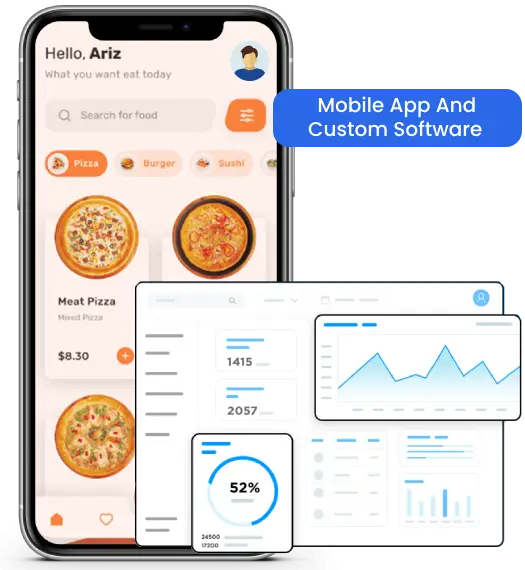The modern businesses are constantly striving to stand out and deliver exceptional products and services to their customers. A major component of product development, especially for web applications, is how users interact with the app. This is where UI/UX design comes into play. User Interface (UI) and User Experience (UX) are critical elements that can either make or break the success of your web app. From customer satisfaction to improved conversion rates, the design of your web app directly impacts the user’s journey. In this blog, we will explore the significance role of UI/UX in web app success, dive into the key roles it plays, and discuss how businesses can design web apps that meet user needs, ensuring long-term success.
What is UI/UX Design?
Before we delve into the importance of UI/UX design, let’s first define what these terms mean.
- UI (User Interface) refers to the visual layout and elements that users interact with, such as buttons, icons, and menus. UI design focuses on the appearance and feel of the app, aiming to create an intuitive, visually appealing interface that users can easily navigate.
- UX (User Experience) encompasses the entire experience a user has when interacting with the app, including its functionality, usability, accessibility, and overall satisfaction. UX design ensures that users can seamlessly navigate the app to achieve their goals, with minimal frustration and effort.
While both UI and UX are distinct areas, they work together to create an optimal user experience. A great UI can make an app visually attractive, but without proper UX, it might fail to meet the user’s needs. Similarly, a solid UX without an appealing UI can result in a frustrating and unattractive interface.
The Impact of UI/UX on Web App Success
As digital experiences become more sophisticated, users are expecting a seamless and enjoyable interaction with every app they use. Poor design, slow navigation, or frustrating interactions can drive users away, leading to high bounce rates and lost revenue.
Here are a few ways that UI/UX design influences the success of a web app:

Improved User Engagement
The most successful web apps are those that offer users an intuitive, engaging, and frictionless experience. If your app is visually appealing, easy to use, and responsive, users are more likely to engage with it and keep coming back. A great UI/UX design encourages exploration, which leads to higher usage and increased time spent on your app.
Higher Conversion Rates
Whether your goal is to drive sales, generate leads, or prompt users to sign up for a newsletter, the ultimate objective of your web app is conversion. UI/UX design plays a crucial role in improving conversion rates. A well-designed user journey leads to faster decision-making by eliminating unnecessary steps, guiding users to desired actions, and offering a seamless transition between each stage.
User Retention and Loyalty
User retention is a key metric for any web app’s long-term success. A great UI/UX design improves the overall experience for users, making them more likely to stick with your app rather than look for alternatives. The smoother the experience, the more likely users will remain loyal, recommending your app to others.
Competitive Advantage
In a crowded digital marketplace, standing out from competitors is crucial. A web app with an aesthetically pleasing and user-friendly design is more likely to leave a lasting impression on users. If your competitors have poor UI/UX, you can gain a competitive advantage by offering a more polished and intuitive app. Great design signals professionalism and trustworthiness, which can elevate your brand and attract more customers.
Reduced Bounce Rates
Bounce rates reflect how many users leave your site or app after visiting a single page. High bounce rates are often the result of poor design, slow loading speeds, or confusing navigation. A well-designed UI/UX encourages users to explore more of your app, reducing the likelihood of them abandoning it after a single visit. By focusing on speed, ease of use, and smooth transitions, businesses can significantly lower bounce rates.
Main Role of UI/UX in Web App Development
Now that we understand the importance of UI/UX design, let’s break down the main roles these two elements play in creating a successful web app.

First Impressions Matter
When users visit your web app, the first impression they form is crucial. UI design impacts how they perceive your app’s professionalism and reliability. If your app is poorly designed or difficult to navigate, users will quickly form a negative opinion. A visually appealing and user-friendly UI creates a sense of trust and professionalism, encouraging users to explore the app further.
Streamlining User Navigation
Navigation is one of the most critical aspects of UX design. A user-friendly interface allows users to easily navigate through different pages, sections, and features. If your app has complicated or confusing navigation, users may get frustrated and leave. A clean and simple layout with well-placed menus and a logical flow of information ensures that users can quickly find what they need.
Fostering Accessibility
A good UX design ensures that the app is accessible to all users, regardless of their abilities. Whether it’s offering keyboard navigation, screen reader compatibility, or color contrast for those with visual impairments, UX design prioritizes inclusivity. By considering accessibility from the outset, businesses can attract a larger and more diverse user base.
Building Trust and Credibility
Trust is an essential factor in retaining users and building long-term customer relationships. An intuitive and aesthetically pleasing UI/UX design contributes to building trust by creating a sense of reliability and professionalism. On the other hand, poor design can create confusion or make users feel uncertain about the legitimacy of the web app, leading to high bounce rates.
Optimizing Performance and Speed
The performance of a web app is heavily influenced by UI/UX design. Efficient design elements, such as optimized images, fast load times, and streamlined user flows, ensure that the app performs well even under heavy traffic. Slow performance can frustrate users and lead to them abandoning the app, negatively affecting retention and conversions.
UI/UX Design Best Practices for Success
Following are some UI/UX design best practices to help ensure the success of your web app:
| Best Practice | Description |
|---|---|
| Consistency | Maintain consistent elements across the app (colors, fonts, icons) for better usability. |
| Mobile-First Design | Design your web app with mobile users in mind, as most people access apps on smartphones. |
| User-Centric Approach | Focus on the needs and behaviors of users to create an intuitive and engaging design. |
| Visual Hierarchy | Organize content to guide users’ attention to the most important elements first. |
| Feedback and Error Handling | Provide clear feedback when users interact with elements and guide them through errors smoothly. |
How to Create an Effective UI/UX Design for Your Web App?
Creating an intuitive and successful UI/UX design requires more than just beautiful visuals. It’s about understanding the user’s needs and ensuring the app’s design meets those needs. Here are some steps to help you create an effective UI/UX design:

Conduct Thorough User Research
User research should be the foundation of your design process. Understanding your target audience is key to designing an app that meets their needs. Conduct surveys, interviews, and focus groups to gather insights about what your users expect from the app. This data will help you design a product that is aligned with their preferences and expectations.
Focus on Simplicity
In the world of UI/UX design, less is often more. A clean and simple design improves usability and makes the app more accessible to users. Avoid cluttered screens or too many distractions that can overwhelm users. A minimalist approach with well-organized content, clear typography, and intuitive navigation ensures a seamless experience.
Design for Mobile-First
With the majority of users accessing web apps from mobile devices, it’s essential to prioritize mobile-first design. Ensure that your app is fully responsive, meaning it adapts smoothly to different screen sizes and devices. A mobile-first approach ensures that the user experience remains consistent across all devices, improving usability for a broader audience.
Test and Iterate
Once your initial design is ready, it’s essential to test it with real users. Collect feedback, identify pain points, and make necessary improvements. Continuous iteration is crucial in the design process, as users’ needs and expectations evolve over time. By refining the design based on user feedback, you can improve the app’s functionality and user satisfaction.
Prioritize Speed and Performance
A slow or laggy web app will drive users away. Ensure that your design elements are optimized for performance, such as compressing images, using lazy loading, and minimizing unnecessary animations. A fast, responsive app will enhance the user experience and keep users engaged.
Why UI/UX Matters for Your Business?
The success of your web app depends not only on its functionality but also on how it resonates with users. Poor UI/UX design can lead to increased bounce rates, frustrated users, and negative reviews, all of which can damage your reputation and hinder business growth. On the other hand, investing in quality UI/UX design can lead to higher user engagement, better conversion rates, and long-term customer loyalty.
Summing Up Everything
UI/UX design is not just about making your web app look good; it’s about creating an experience that is easy, intuitive, and enjoyable for users. From the first impression to the final interaction, the design of your app has a direct impact on how users perceive your business, engage with your product, and ultimately decide whether or not to stick around. By focusing on UI/UX design, businesses can increase user satisfaction, boost conversion rates, reduce bounce rates, and build brand loyalty. So, make sure to prioritize UI/UX design in your web app development strategy— it’s not just an aesthetic consideration, but a critical factor in your app’s success. Choose custom mobile app development services by Dreamer Technoland to create appealing and scalable applications for all screen sizes.







